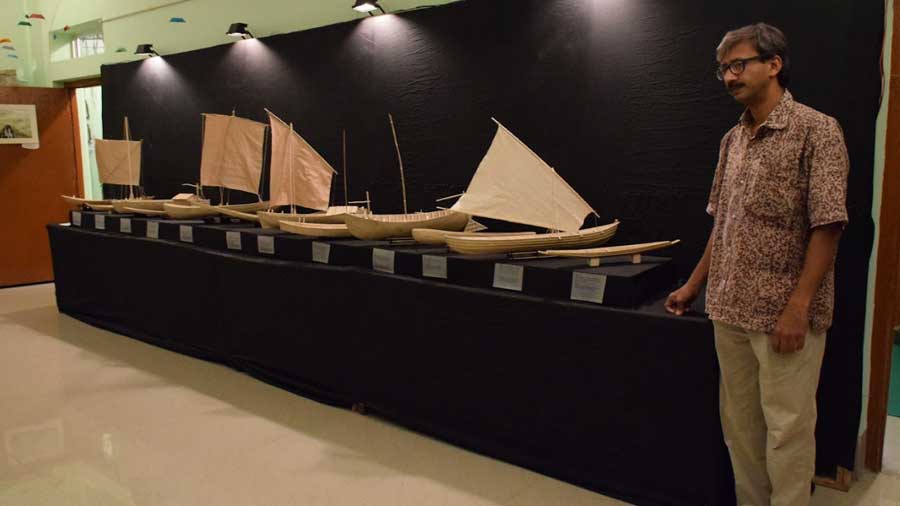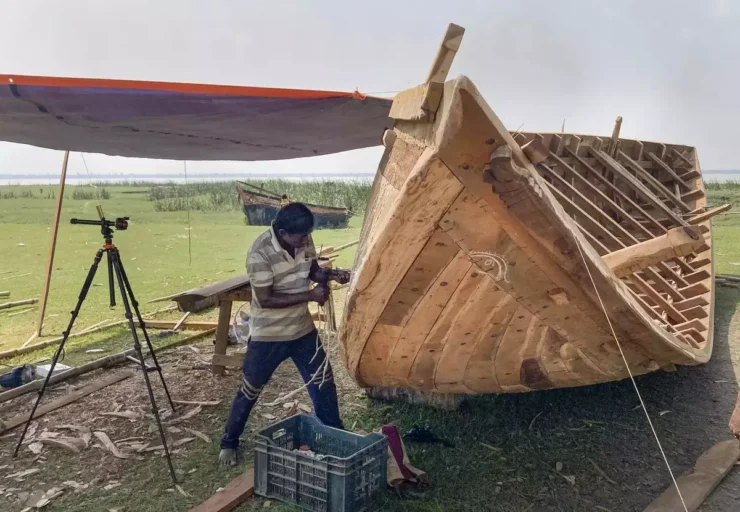A hand tooled seagoing boat is being reconstructed behind a bamboo goal post on a tiny football field called Amberia by the only remaining artisans who can construct such ships, just across the river Rupnarayan from the old port of Tamralipta or Tamluk.
The project, which is being funded by Britain’s Endangered Material Knowledge Program, is a dream come true for Swarup Bhattacharyya, a well-known anthropologist and maritime ethnographer. It intends to build a square-rigged cutter ship called a ‘Chhot’ (Runner), which was produced in this area for generations.
“No one is sure when the technology to build these V-shaped boats, similar yet very different from Europe‘s Viking boats, emerged. But we know that the boats were used for long to ply in the Bay area. However, now for many decades, such boats have been replaced by motorised ones and the know-how to build these crafts is disappearing.” said Bhattacharyya.
A group of craftspeople led by 70-year-old Panchanan Mondol, one of the last master boat builders, has attracted big crowds of river craft operators and fisherman for whom the attempt to construct the antiquated boat has become a source of pride.
The Greek geographer Ptolemy and the Roman philosopher Pliny both mention Tamralipta as a bustling port that flourished in the third century BC. Tamralipta served as both the entry point for ancient Bengal and the pan-Indian Mauryan empire. It was only natural that a boat-building business built up over history using both local wood and teak sourced from forests that could be reached by the river route.
“There is clear evidence of ships sailing to Sri Lanka and other Southeast Asian countries from the port of Tamralipta on the Bay of Bengal. The third-century Jatakas mention traders sailing from this port to Suvarnabhumi with ships loaded with wealth, possibly from Java and Sumatra “said Professor Suchandra Ghosh of the University of Hyderabad, an expert on India’s longstanding ties to Southeast Asia and the author of several books on the subject.
A painting by Flemish artist FB Solvyns, which was published in his book on India in 1799, is the earliest example of these “Chhot” boats, which feature distinctive left-to-right downward sloping planking and are held together by iron staples and rivets.



The majority of the Indian records of ships utilized, derived from temple carvings, are of royal barges and beautiful craft, omitting to preserve the engineering aspects of more often used, more practical ships.
“The V-shaped structure of the ‘Chhot’ gives it an ability to navigate high waves, which would allow this boat to negotiate through seas, possibly as a coast-hugging craft. As it has the ability to cut through waves, it is a fast ship which suggests there could have been military usage for it. Though we can only guess this,” said Zeeshan Sheikh, a British marine archaeologist working with Bhattacharyya. Professor John P. Cooper of Exeter University and Professor Vasant Shinde of Central University of Haryana are two additional archaeologists working on the project.
This boat-building method seems “unique to Bengal and Bangladesh and extremely distinct from what we find on the west coast or in the Gulf,” according to Sheikh, who has previously worked on maritime archaeology and ethnography projects in the Red Sea and Gulf regions.
Mondol and his crew are constructing a boat that is 35 and a half feet long overall and 9 and a half feet long in the midsection. Bhattacharyya noted that “this is scalable and in ancient times larger boats up to 100 feet may have been built”
According to the reports of The Economic Times, the boat project, which began in early October, is anticipated to be finished this week. After that, in the presence of numerous officials, the ship with a single mast and square sail may travel along the river Rupnarayan before being carried to the National Maritime Museum at Lothal.
Up until now, shipbuilders have passed this knowledge on to their sons through practical training and word of mouth. The knowledge of the local technology will be digitized and kept at the British Museum for future generations to learn from.
